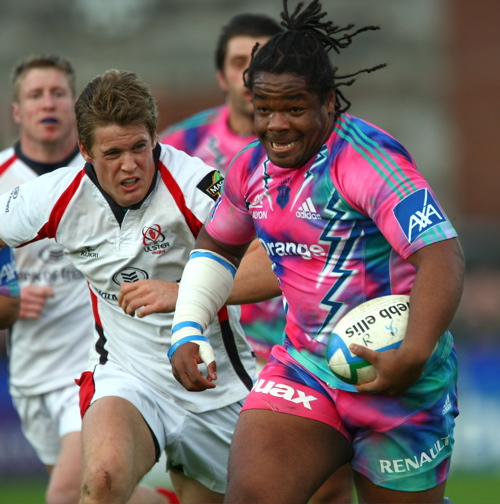
Who would you pay to see? The dude with the pink motifs or the guy with the colourless togs.
The French national rugby team is the strongest in Europe having won the most Six Nations titles including the most recent one earlier this year. Unlike their footballing counterparts they have seen few controversies while achieving such success.
With Thierry Henry’s scandalous reenactment of Maradona taking them to the World Cup, a coach that is a figure of derision for most of his countrymen and players too, and now a sex scandal engulfing some of the team’s top players, it comes as no surprise that the public might be a bit blase about the national game.
Les Bleus is also a politically polarizing team with its multi-ethnic hue raising the question of national identity during election time. A political firestorm was set off when an performer singing Le Marseillaise before a match against Tunisia got booed for singing the national anthem. Such potentially divisive moments could arise in the event France meets one of its former colonies on the playing field.
The French Ligue also regularly loses its top talent to the bigger and more lucrative European leagues. Richer clubs regularly poach young players, offering bribes to them and their parents, which has led to UEFA’s president Michel Platini calling for protectionist measures. Other factors include declining match attendances and fan violence seen regularly at clubs like PSG and L’OM.
The LNR, the French rugby league has in contrast effected a remarkable turnaround. In the past, French standouts like Frederic Michalak, Thierry Lacroix, and Phillipe Sella would move to the more lucrative South African and English leagues. But all that has changed.
The Top 14, LNR’s top divisions is now one of the richest leagues eclipsing the English Rugby Premiership in player wages. On average the Top 14 player is paid $153,700 versus $123,000 in England. The bullish environment is helped further by no salary caps and a weaker pound. The French clubs have raided English clubs like Saracens, Sale, and Wasps leading to an across the channel exodus.
Moreover, France is the beneficiary of the breakdown of the traditional North- South divide between Europe and SANZAR (South Africa, New Zealand, and Australia). In the past northern contracts were only allowed when the player called time on their international career. But the huge differences in payer wages have left little patience for pension benefits. France has become the preferred destination of this northbound winter flight.
A look at Perpignan’s roster, the top club in the 14, includes 12 players from other countries. Their notable players include Dan Carter, an All Black fly half who helped them win the title and Percy Montgomery, the Springboks all time leader in appearances. John Smit the Springbok captain signed for Clermont Auvergne. Byron Kelleher, one of the best half back prospects to come out of New Zealand signed on for Agen, and then transferred to top titled Toulouse.
The increasing popularity of rugby is reflected in the steady rise in matchday attendances and TV viewership. The final between US Perpignan and Clermont Auvergne attracted 79,205 fans at the Stade de France. This is far in excess of top football attendances including national appearances. A 700,000 viewership compares very favourably to football’s 1.7 million on weekends and the number of TV subscriptions continues to grow. Clubs confronted with overflowing stadiums are looking to building larger ones or moving to the bigger municipal stadiums.
A major factor in such a surge is that the Top 14 clubs are amongst the elites in European top flight. The Heineken Cup, the rugby counterpart to the Champions League is regularly contested between French clubs. This year three time winner Stade Toulousain takes on Olympique Biarritz. In all, French clubs have won four titles and been eight times runners up. An impressive record for a 15 year old competition.
L’OM’s 1993 Champions League title remains the Ligue’s singular European achievement.
The Top 14 have their Roman Abramovich’s and Glazers. Comic book publisher, Mourad Boudjellad, bankrolls Toulon as does real estate magnate Jacky Lorenzetti with Racing Metro. But the culture of the bottomless bank accounts began with radio entrepreneur Max Guazzini when he bought Stade Francaise in 1992. He was soon accused of buying his way to the top. Guazzini seems to be part owner, part impresario bringing a sense of theatrics and a penchant for pink kits to the game that is part of the growing attraction for rugby. Filling the Stade de France on discounted tickets as cheap as €5 to €10 might give rise to a pretense but regular 80,000 attendances are ensured.
Top 14 clubs are located in small towns spread mostly over the more southern and coastal part of France with strong regional affiliations with the Basque and Catalan communities. Although they are sometimes at odds with Paris over their autonomous aspirations, for most part rugby retains a strong Gallic quality. Fan violence erupting in the Algerian section in Marseille after the Fennecs played Egypt in Cairo are indicative of a schism. Rugby stands to gain from football’s divided loyalties.